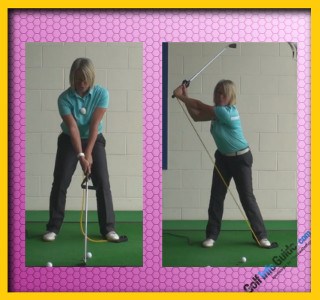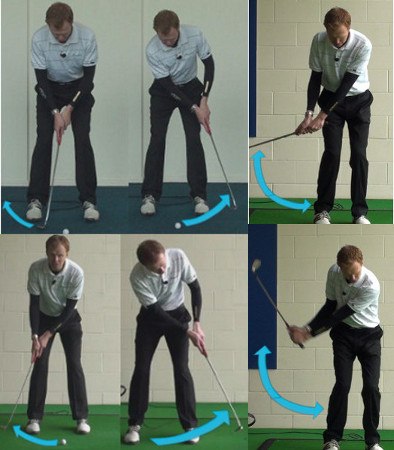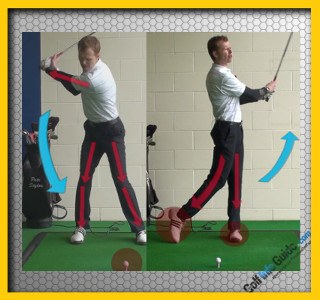
Practicing your golf game is kind of like eating your vegetables. You know it's good for you, but it's not very enjoyable. Just as you'll finish a whole steak and leave half your broccoli on the plate, it's easy to skip the driving range and head for the first tee.
Like eating only good-tasting foods with marginal nutritional value, ignoring practice in favor of all play will eventually catch up with you. You'll fail to improve your weaknesses and bolster your strengths. You won't develop new skills or learn the intricacies of your swing, a key to self-correcting when things go sideways.
In short, your game will stagnate. If you truly want to play better golf, then you've got the basic motivation to increase your practice effort. But you still need a plan to make practice palatable, to make your work worthwhile. That means:
1. Setting a long-term, big-picture goal that's challenging but within your capabilities to achieve—shaving six shots off your handicap in six months, for instance.
2. Breaking down your big goal into smaller increments—improving by one stroke per month, in this case.
3. Identifying areas of your game most in need of improvement—perhaps more proficient short putting, or better driving accuracy.
4. Making practice more fun by using golf drills—they'll challenge you and provide positive reinforcement during each practice session.
5. Tracking your progress to confirm that your labor is paying off—if you're working on short putts, note your percentage inside five feet during rounds; there's a great chance you'll see noticeable improvement.
Once you discover the positive results of practice, you'll be motivated to continue. In fact, you may even come to enjoy working on your game. Don't scoff -- lots of people like vegetables, after all.

Why Practice is Good for Your Game
Practice is a good thing for your golf game. Sure, that might seem like an obvious statement, but you would be amazed to learn how many golfers never actually take time to practice. Even golfers who are completely obsessed with the game can find themselves walking past the driving range to reach the first tee day after day. To make sure you actually are able to progress with your game as time goes by, you will need to get into the habit of practicing regularly.
In this article, we are going to highlight the many ways in which practice can benefit your game. By gaining a better understanding of why practice will help, you should find yourself more motivated to get out there and put in the work. You don't have to be a professional golfer to benefit from spending some time on the driving range and in the short game practice area. All golfers would like to play even just a little better as time goes on, and your ticket to that improved play can be earned through practice.
It needs to be noted right away that you don't have to have a ton of free time in your schedule in order to get better at golf. We are all busy, and unless you are a pro golfer, you can't just dedicate several hours a day to your pursuit of lower scores. And that is okay. You can get better even by spending just 10 or 15 minutes practicing once or twice a week. The key is to spend your time wisely. By learning what you should be working on – and how you should be working on it – you can take steps forward without carving out any significant time from your schedule.
Before you get into the habit of practicing your game regularly, you are going to need to find a good place to practice. As you evaluate the various golf facilities near you, one thing to consider is proximity to your home or office. It will be easier to practice if you don't have to spend a significant amount of time driving to the range. Even if you have to use a slightly lesser driving range to save time, that trade off will probably be worth it in the long run. It doesn't really matter how nice the facility is, as long as you are able to get your work in.
All of the content below is based on a right-handed golfer. If you happen to play left-handed, please take a moment to reverse the directions as necessary.

The Benefits of Practicing Your Swing
When most people think about golf practice, they think about practicing the full swing. Of course, golf practice should include the short game as well, but let's start by talking about how your swing can benefit from regular practice. Building a quality swing is a serious challenge, and you aren't going to get there on the course alone. To create the kind of swing needed to play good golf, you will have to find yourself on the range from time to time.
Included in the many benefits of practicing your swing are the following points –
- Sharpening your hand-eye coordination. It takes great coordination to put the club on the back of the ball cleanly time after time. Many golfers struggle with this task, and often that struggle is due to a lack of practice. If you are willing to put in the time on the range to gain experience with your swing, you will gradually notice that your ball striking is getting better and better. Nothing can make golf an easy game, but it will get easier as you go. The golf swing is not necessarily a natural action, which is why practice is so important to your success. Accrue as many swings as you can in practice and that experience will pay off for you nicely on the course.
- Learning your ball flight. During practice sessions, you will start to notice patterns with your ball flight. Some golfers turn the ball from right to left most of the time, while others hit shots that move in the opposite direction. It would take a long time to learn your ball flight patterns if you exclusively spend your time on the course. During a single range session, you may be able to learn as much as you would pick up during three or four rounds. Of course, you are only going to learn about your ball flight if you are willing to watch it carefully as it travels down the range. Don't immediately look down to load up another ball after sending one into the distance. Make it a point to watch your shots from start to finish before moving on to the next swing. Think of your time on the range as a research project – you are trying to learn as much as you can about your game so you can apply that information during an upcoming round.
- Building confidence. The golf course can be an intimidating place, especially for a new golfer. If you find yourself feeling nervous and anxious when on the links, adding practice time to your schedule may be the answer. When you practice, you will be building up confidence by seeing shot after shot come off of your club and fly off into the distance. The only way to build confidence is through repetition and experience. If you have not hit any shots since your last round, you won't have much of any reason to feel confident about your play. Prove to yourself that you have what it takes on the driving range first, and your self-confidence will soar. That way, when you have other people watching you tee off for your next round, you won't have to doubt yourself.
- Gaining golf strength. You probably don't think of golf as a game which requires significant strength, but you do need to have the right muscles in the right places. The only way to develop the strength needed to play golf is to hit balls on the range. Think of your practice sessions in part as a golf workout – you will be building up strength in the specific areas of the body which need to work hard to swing a club. Over time, those parts of your body will grow stronger, and your swing will be more powerful as a result.
- Get comfortable with all of your clubs. Golfers who rarely visit the driving range tend to have just a couple clubs they trust on the course. Since they haven't spent the time necessary to learn how to use the entire set, these players fall back on the same clubs time and time again – even if those are not the best clubs for the job. To avoid this kind of game, spend some time on the range working through your entire set on club at a time. As a handy practice routine, try hitting two shots with each of your clubs while moving from shortest to longest. Start with your shortest wedge and hit two shots with each club from there all the way up to your driver. Once that progression is completed, you can go back and hit extra shots with any of the clubs that you think need more work.
If you want to get better at golf, you need to practice your swing. You can be sure that the players on the PGA Tour all work very hard on their swings, and you should be doing the same (to a lesser degree, of course, since this is not your job). With consistent swing practice, your play will improve and you will have more fun on the course as a result.

The Benefits of Practicing Your Short Game
While the full swing is where most people spend the majority of their attention, it only makes up roughly half of this game. In any given round, you are likely to play approximately half of your shots either on or around the greens. Knowing how to putt and chip effectively is a critical skill as you build up your game. The goal in this game is to get the ball in the hole, and that simply can't be done without a quality short game.
So how will you stand to benefit if you practice your short game consistently? Check out the points below.
- Find your touch. The concept of 'touch' is one which is lost on many players. Basically, touch means the ability to hit the ball the right distance in the short game. A player with good touch is able to roll or chip the ball the right distance over and over again. Since you aren't making a full swing, distance measurements in the short game are not nearly as important as they are on full shots. For example, if you know that you have 150-yards to the target, you can pick the appropriate club and swing away. The short game does not work that way. If you have a 15-foot putt or a 50-foot putt, for example, you will still be using the same club either way. So, to get the ball to go the right distance, you have to put your touch to use. And, the only way to develop that touch is through practice. As you gain experience, your mind and body will get better and better at working together to send the ball toward the cup. Not only do you need to practice your short game ahead of time to develop touch, you also need to warm up your touch before each round by hitting some putts and chip shots.
- Learn to produce a variety of swings. This is not an issue when putting, but it is extremely important when you are chipping or pitching from around the green. Thanks to the varied design of golf courses, you aren't often going to draw a 'standard' lie for a short game shot. You will usually find your ball on some kind of slope, and it may even be sitting in some long grass. Through practice, you can teach yourself how to deal with these various situations. It isn't good enough to just have a standard chipping technique that you use on all of your shots – you have to know how to adjust your approach based on the circumstances at hand. Expose yourself to as many different types of short game shots as possible in practice and your results on the course will improve.
- Steady your nerves. If possible, it is good to put yourself under a bit of pressure while practicing your short game. Some golfers do this by creating a competition with one or more of their friends. Set up a little short game contest and then do your best to prevail over your buddies. Adding even just this kind of casual pressure will teach you how to come up with the right shot at the right time. Nerves are notorious for messing with short games, especially late in a round when you start to think about the score you may be able to shoot. Find ways to create pressure in practice so you aren't caught off guard when the butterflies affect your putting stroke during a round.
- Build confidence. This is a point we listed in the previous section, but it applies here as well. Specifically, it is important to build confidence on short putts. When you get within close range of the hole, you start to expect to make your next putt. That expectation leads to pressure, and that pressure may cause you to make a mistake. To insulate yourself against that pressure, you should make as many short putts as possible during practice. Many golfers choose to start and finish their short game practice with a series of short putts, and you should consider doing the same. By seeing the ball drop into the hole over and over again, you will believe in your ability to replicate those results on the course.
The short game is just as important as the long game. Even the best swing in the world is not going to help you make a tricky five-footer, which is why it is important to build a well-rounded game. Take the time to practice all aspects of your short game and you will be well-prepared to rise to the challenges you face when chipping and putting.

Practice Tips
It is one thing to dedicate yourself to practice – it is another thing to practice in the right way. If you practice poorly, you could actually do harm to your game. To make sure you are moving in the right direction, we wanted to offer a few tips on proper practice.
- Practice like you play. This is a classic golf tip, and it is one of the best you can receive. When on the range, or on the practice putting green, you should do what you can to replicate the experience you will find on the course. For example, don't just stand on the range hitting the same club over and over again for 10 or 15 minutes. When would you ever have the chance to do that on the course? Never, obviously. Sure, it's okay to hit a few balls in a row with the same club when trying to build confidence, but don't let it go much farther than that. Switch clubs frequently as you practice to replicate the experience you will have when playing a round. Also, consider practicing your putting with just a single ball most of the time. By using one ball, you can take your time to get a read, make a good stroke, and observe the results. It is easy to get caught up in rushing through your practice when using several golf balls.
- Pay attention to the details. Good golf practice is not about hitting as many shots as possible within a given period of time. Rather, it is about executing your technique as perfectly as you can, over and over again. Pay attention to the details in practice, just like you pay attention to them on the course. Go through your pre-shot routine each time, carefully align yourself with the target, and swing with a quality tempo. By not cutting corners during your preparation, you will be that much better prepared to play well during upcoming rounds.
- Keep to yourself. In general terms, golf is a social game. This is one of the things that so many people love about the sport. You can get outside, enjoy a beautifully landscaped course, and spend several hours with your friends. However, during practice, it is a better idea to keep to yourself. Try to find a quiet end of the range to practice, and consider putting your headphones on to keep other people away. There will be plenty of other chances to strike up conservations on and around the course – during practice, do your best to focus on the task at hand.
- Be consistent. We understand that you probably don't have the time available in your schedule to practice golf every day, or even anything close to that. However, you should strive for consistency in your golf practice schedule. For instance, maybe to try to practice on your lunch break every Wednesday, or after work on Thursday. Whatever the case, do your best to stick with a fairly consistent schedule so you can stay on track toward better performance.
It should be no surprise that good practice habits will lead to better results on the course. Teach yourself how to practice effectively and then apply those skills time after time, as you visit the range and short game practice area.

A Few More Thoughts
To wrap up, we would like to share a final few thoughts on the topic of practice in golf. The first thought relates to saving a bit of money along the way. You will notice that the cost of range balls can start to add up if you make more and more visits to the practice tee. To save on this cost, look for practice memberships options in your area. Some golf facilities will charge a flat monthly fee in exchange for providing you with range access and all the golf balls you can hit. If you are consistent about getting out to practice, this kind of membership will pay for itself in short order.
Also, consider using a couple different golf facilities for your practice needs, based on the amenities they have available. For instance, one course near you might have an excellent driving range, while another location may have the best short game practice area. One of these two may need to be your 'home base' due to location, but try to get to the other one from time to time as well.
Finally, we want you to remember that you should be having fun while practicing. Sure, you can be serious about the process of improving your game, but that doesn't mean you have to drain all of the fun out of the game along the way. Golf is something you do in your recreation time, so you should be enjoying it at every turn. If you notice that your practice sessions are starting to feel more like work than anything else, consider making a tee time to get back out on the links and take a break from the range.
It is nearly certain that you will improve your game if you dedicate yourself to consistent practice. How much better will you get, and how quickly? Well, that is up to you. If you are able to practice frequently, and you focus on the task at hand while practicing, you may be able to cut strokes from your score in the near future. We hope the tips provided in this article will help you in the process of becoming the best golfer you can be. Good luck!






